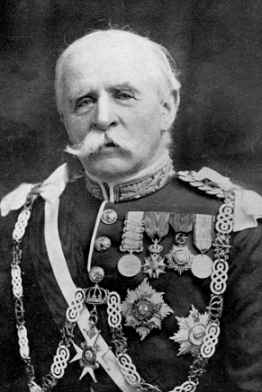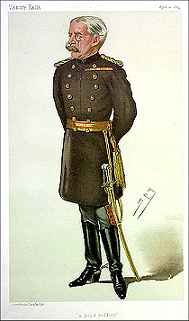General Sir George Higginson GCB GCVO KCB
Appointed Colonel of the Regiment in 1893. General Sir George Wentworth Alexander Higginson, G.C.B., was born on 21st June 1826, he joined the Grenadier Guards in 1845 and served as Adjutant in the Crimean War. In Lady Butler’s well-known picture, “The Roll Call,” it is Higginson who figures in the foreground. From the date of his appointment as Colonel in 1893 Sir George Higginson associated himself closely with every aspect of regimental life, and when he died on 1st February 1927, there was no one actually serving with the Regiment who could remember the days before him. With the passing of a grand old soldier in his 101st year the work of one who had come to be regarded as an institution was ended. The General spent his childhood in West London when it was a series of villages and fields. He was educated at Eton College. As a young Grenadier he fought throughout the Crimean War and was twice promoted for services in the field. During his career he travelled extensively on military affairs to Ireland, Canada, France, Italy and Russia. Most notably he spent time in America during the American Civil War. His American connections date back 400 years to the witch hunting town of Salem. His family descends from the brother of the famous Francis Higginson, the dissenting vicar of Claybrooke, who became minister of the infamous Massachusetts town in 1629. The general held many foreign decorations as a result of his service abroad but he is not the only decorated military man in his family. His father, General Powell Higginson, had been a Grenadier and had carried the colours at the famous Battle of Corunna. Having served more than 30 years in the Grenadiers in 1882, the General was ordered to assist in the now defunct Royal Tournament. His promotion to general followed his appointment to the command of the Brigade of Guards. From 1888 to 1893 the General was the Lieutenant Governor of the Tower of London, when he then became the colonel of the Worcestershire Regiment. |
General Sir George Higginson |
|
The general became a personal friend of the Royal Family including Prince Albert but was more close to Edward VII. Together the general and Edward were part of a committee set up to create a home for 'homeless and friendless lads'. The home remained of close personal interest to the general and in his autobiography, '71 Years of a Guardsman's Life', he quotes a letter of support from Florence Nightingale. Following his retirement from the army, Sir George became chairman of the governors of Sir William Borlase's School, chairman of the directors of Marlow Water Company, vice president of Marlow Regatta, vice president of Marlow Institute and Horticultural Society, president of the Marlow British Legion branch and vice president of the Marlow Cottage Hospital. In 1926 the General reached his 100th birthday and it was only a few months later, in February 1927, that he died. His funeral was reported as being the grandest affair Marlow had ever seen. Flags in the town were all at half-mast, shops were shut and blinds were drawn. Hundreds of people lined the route of the funeral procession. Eight guardsmen in full uniform escorted the coffin, on top of which lay the general's sword and plumed hat, to his final resting place at All Saints Church on the riverside.
The colour print on the left of General Higginson is with the kind permission of Vanity Fair Prints.
|


